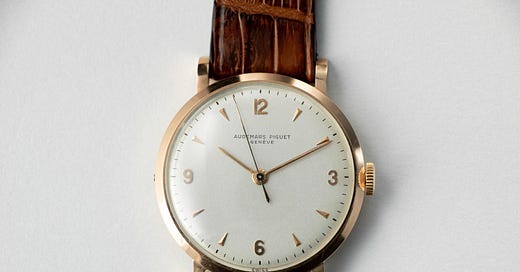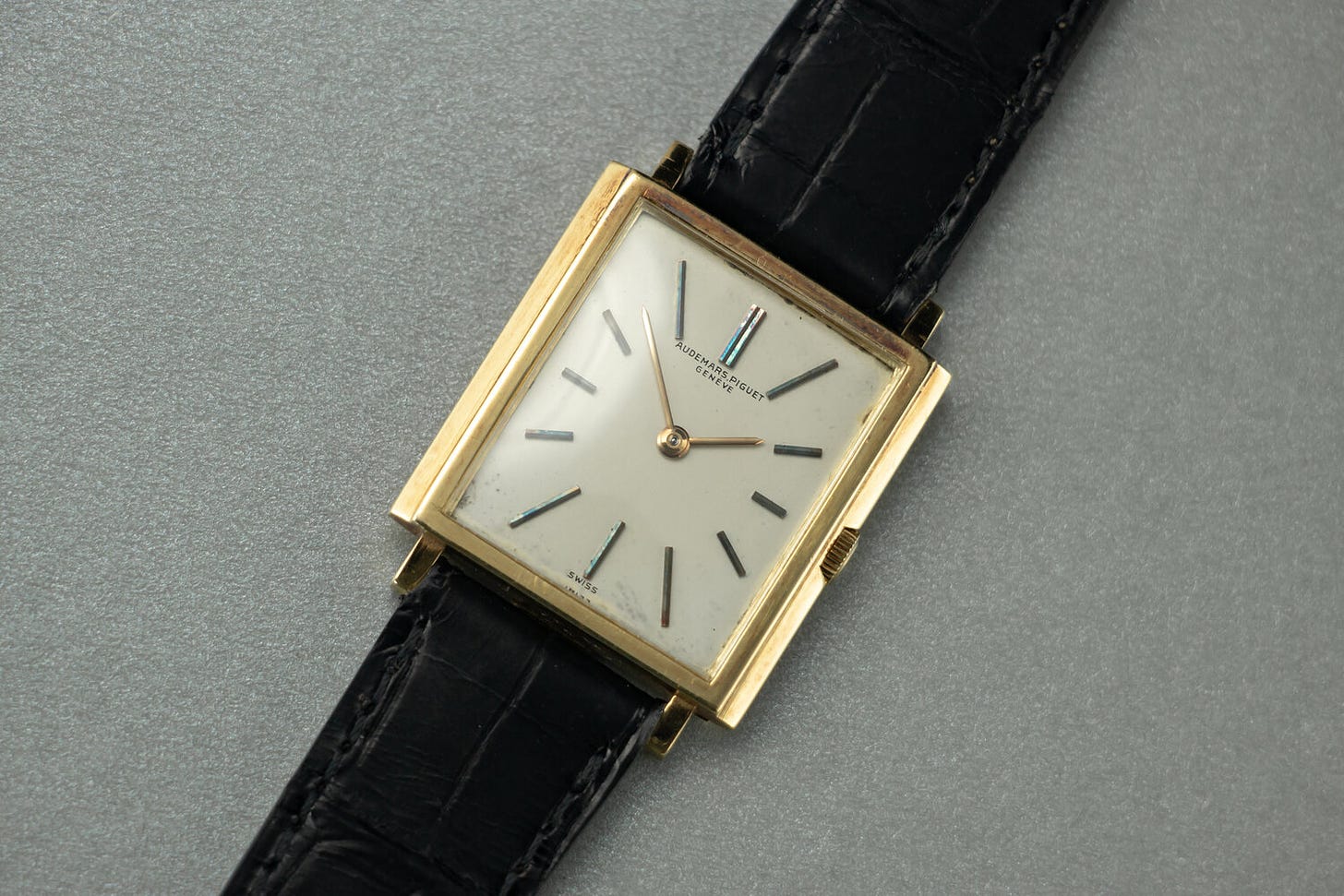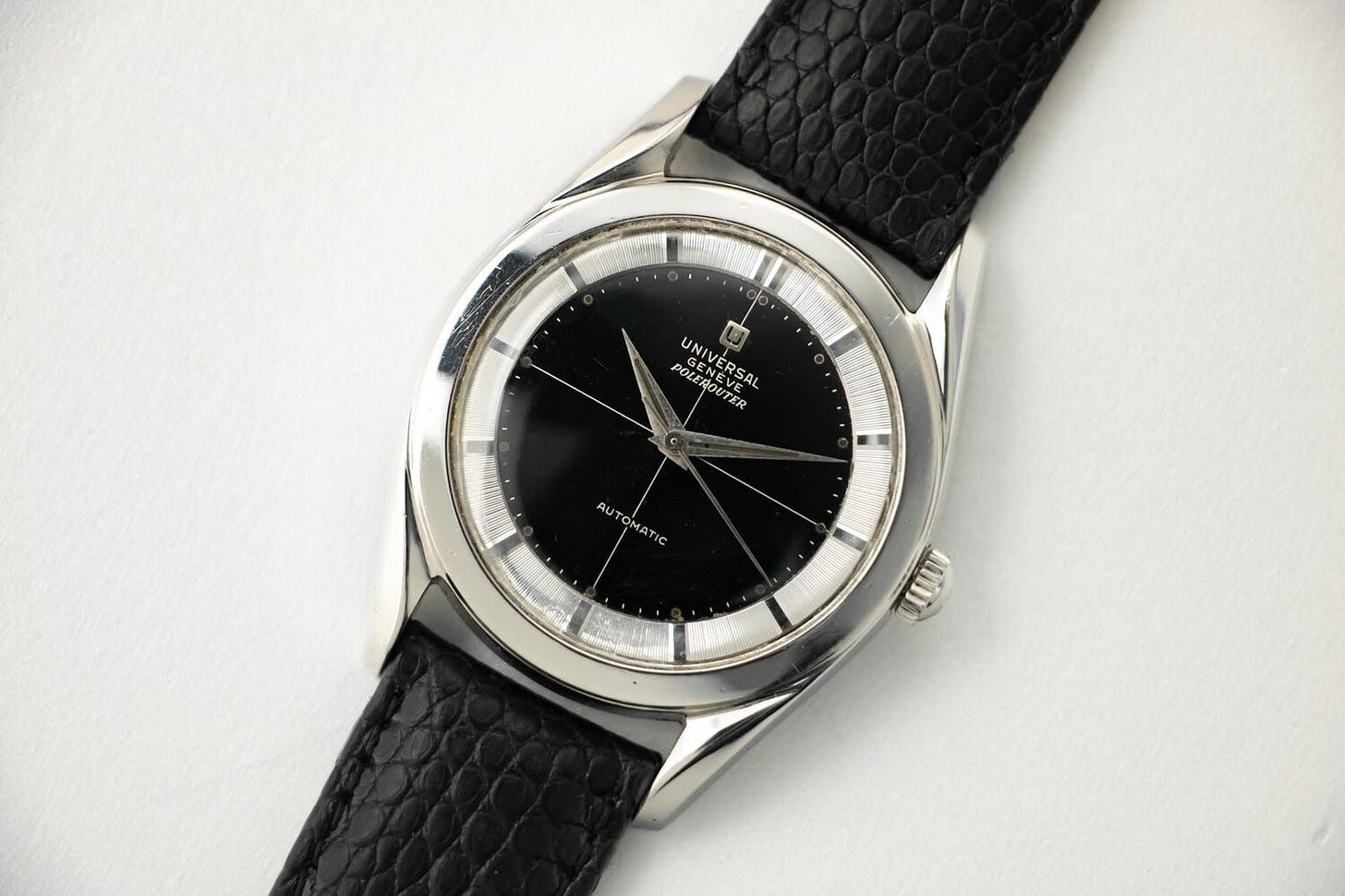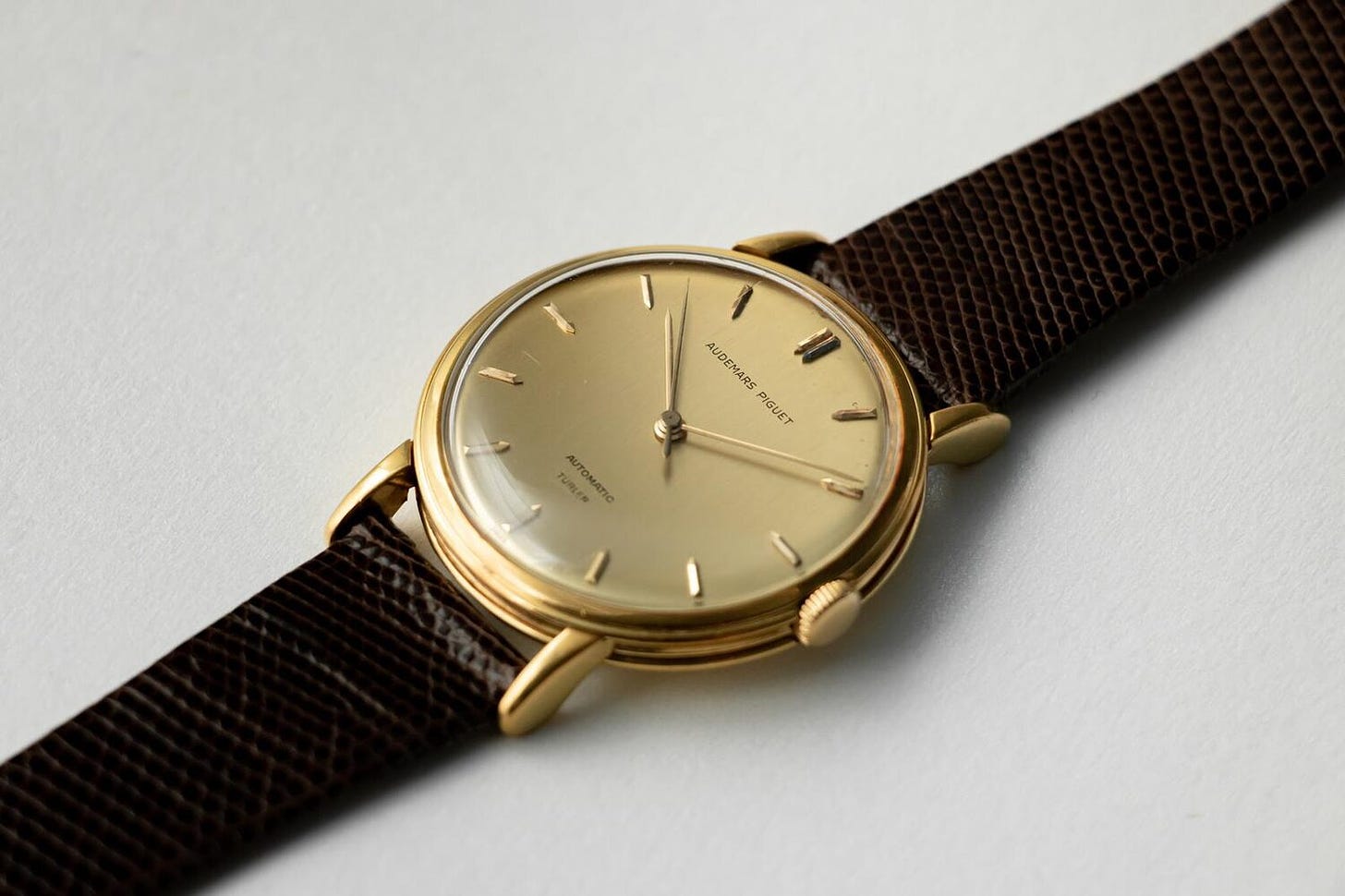Audemars Piguet and Genta from outside the Mainstream
A Rolex Space-Dweller; Franck Muller v. Rolex; exploring AP and Genta outside the mainstream
Audemars Piguet and Genta; Rolex v. Franck Muller; A Rolex Space-Dweller up for auction; and what is the measure of a good company?
Audemars Piguet & Genta — no, not the Royal Oak
“We’re not mainstream and we’re proud of it,” Josh Rankin proudly proclaims on the website of Stetz & Company, the vintage dealership he started in 2016. Josh is an unabashed lover of Gerald Genta and Audemars Piguet, but maybe not the stuff you’re thinking of — his tastes are a bit more offbeat, and to be honest, more fun. He carefully curates a collection of vintage watches defined by design, historical importance, or whatever other quirks Josh finds interesting — for example, watches powered by Audemars Piguet’s VZSS caliber, the time-only movement developed from the robust Valjoux 13" (“VZ”) chronograph caliber first introduced in the 1910s.
I had the chance to chat with Josh about life as an entrepreneur, enthusiast, and vintage dealer, while also highlighting some of his most exciting recent pickups. Below is a slightly condensed version — click here for the full discussion.
All photos courtesy of Stetz & Co.
Q: Could you give a short introduction to yourself before you got into watches?
I always knew I wanted to build a business for myself, I just didn’t know what. The idea of being an entrepreneur was always appealing. My dad was a mechanical engineer and roped me into working on cars, and cars pulled me into having an interest in mechanics in general.
My first watch was the Mickey Mouse watch kids got back in the 80s. I thought it was so cool, and wanted to know how the watch worked. Then in my high school years, I found an old King Seiko in a thrift shop. It was super cheap, but there was something about it that made it look different from the other watches so I picked it up and was hooked from there.
Q: Talk a bit about launching Stetz. and Co.
When I get into something and get passionate I tend to get obsessive. It was 100% borne out of passion and something I was doing just for me and out of my own curiosity.
I didn’t see it being terribly profitable, but if I could have a business I’m extremely passionate about and at least break even, why not? A lot of the stuff I buy is outside the mainstream, but watches I find personally interesting. It could be a dial design, a certain technology in a movement, or where it came from in history. With vintage, the appeal is that added dynamic of being born in a certain era that is no longer here, so we feel that romantic attachment to it.
Over the past couple years that passion has been vintage Audemars Piguet, and I still think there’s so much value there. The market is slowly waking up to it and realizing you have to really be patient and look; with collectors like Roni it’s a little bit more on their radar now, for better or worse.
Q: What is it about vintage Audemars Piguet that you’re drawn towards — dials, case designs, movements, history?
It’s a combination of all of that.
With AP, I think it’s fascinating how they took the VZ movement — a movement that was developed in the 1910s as a chronograph — and they used this big, beefy chronograph movement to power time-only watches that are so understated.
Then let’s talk about design. Genta said he designed every single AP timepiece from 1953 until the Royal Oak. He had some wild, out there designs and he had some understated stuff. The designs you find at AP you just don’t find at any other houses. Even in the 1940s before Genta, it was very sparse and Bauhaus before he came in and put his spin on it.
Then you get into the AP story, and the founding family still owns the business today which is pretty cool; you don’t see that kind of longevity.
All of it together: The design, the movements, the history, and the lack of information makes it fun, a bit more of a challenge and keeps it interesting.
Q: What are some tips for people interested in digging into this part of AP’s history?
Strangely, the Internet forums are kind of silent on pre-Royal Oak AP. My go to is the Audemars Piguet book by Brunner, Pfeiffer and Wehrli. Although when they wrote it there wasn’t an emphasis on original dials so you will see refinished dials in it. My advice is to reach out to the guys who are in it and have been in it. People are generous in giving information and will help out.
Another tricky thing with AP is the signatures on the dials. They didn’t use one standard signature — it probably depended on what subcontractor was making the dials — so I put up a post where I arranged these dial signatures by the year according to the serial number on the movement.
Q: Are there other potential areas in vintage that offer a value proposition?
There’s still so much value in JLC (Jaeger-LeCoultre). I still haven’t quite figured out why they haven’t gotten their due, knowing they’re the ‘watchmakers watchmaker’, making movements for half the brands we consider higher end than them. I also love vintage Girard Perregaux, there’s a lot of value there even though a lot of their movements were not in-house. As far as Rolex: I love the traditional Datejust case, and it’s aged so well.
Q: In your personal collection, do your interests diverge from what you post on Stetz & Co.?
I’d like to pick up one or two modern pieces. I’d like to pick up a G-Shock. I know this is way off, but it’s just one of those watches — every high end collector needs a G-Shock stashed somewhere.
I love Nomos’ understated designs. A lot of it is inspired by vintage Longines — you’ll find some almost identical copies, but they’re super nice watches to look at.
Q: Any recent pickups you’re excited about?
I’m really excited about an AP pink gold stop balance (photo above), an insanely rare find that came from Adam Victor. In their registers, AP didn’t annotate whether an example was a stop balance or not, so we can’t see how many were made, but Adam said he’s only seen four of them.
Q: Is there anything that you’ve read or watched recently that you’d recommend?
The video interview that WatchTime India recently did with Gerald Genta’s wife. We put the man on a pedestal, but to hear her say, ‘he was a terrible businessman; he was an amazing artist but I ran the business.’ It gives you a chuckle.
I also just found a first edition of Salomon’s 1921 Breguet book. The illustrations are amazing, and you get to climb inside Salomon’s mind and see how he was talking about collectors and the market in 1921.
Q: Talk a bit about Genta’s lesser known works and what you’re drawn to about them.
[Ed. note: Check out Josh’s excellent piece, The Unsung Audemars of Gerald Genta for more.]
His relationship with geometry was so different from anything else that was going on at the time. A lot of times it was just taking the simplest form and putting it in a certain place, scaling it to a certain size, and not doing anything that was the genius. There are some pieces where the genius lies in the simplicity. A good designer knows when not to put something in a space just as much as when to put something in a space.
There’s a 1953 square piece — I still think that’s one of the more interesting pieces, knowing that it came from his first year. With the balance of it, you can tell everything was so precisely thought out. Nothing overpowers anything else.
Q: Anything else you’d like to say or promote?
It’s as good a time as any to remind people that there’s no wrong reason for collecting. We all just sometimes need to check ourselves and be more respectful to people online. I see a lot of bashing. You don’t have to like every watch, but if you don’t have anything nice to say, perhaps don’t say anything. Just be kind to your fellow collector, even if you don’t like what they collect.
Visit Stetz & Co. for more, and follow Stetz & Co. and Josh on Instagram.
Get to know Josh, and you’ll start to understand the purpose behind every watch he curates, almost crafting a narrative of mid-century watches and design. Here are some of the best pieces available now at Stetz & Co.
Universal Geneve Polerouter Ref. 20217/4
Of course, where else can a Genta aficionado start but with the Universal Geneve Polerouter? It’s the perfect introduction to Genta, if not all of vintage watches. Many know the story (and if you don’t, head to one of the Polerouter links on our Resources Page), but to give the one liner: The Polerouter was designed by Genta and launched by Universal Geneve in the early 1950s to promote Scandinavian Airlines polar flights that connected Los Angeles, New York and Europe via a new route across the north pole.
This early example from 1956 is particularly attractive: The glossy dial is a deep black, with lyre lugs that retain their distinctive twisting shape. With no date and crosshairs divvying up the dial, it has a certain symmetry that makes the design particularly alluring — I can’t help but think this is Genta in his purest, most harmonious form. See it here.
Audemars Piguet Ref. 3123BA retailed by Türler
From a nice “introductory” watch straight into the deep end. This is an Audemars Piguet Reference 3123BA, retailed by Zurich-based jeweler Türler. The 18k yellow gold case, with its elongated lugs and slightly stepped bezel provide an elegance that highlights the absolutely pristine, vertically brushed gold dial, with the stamp of Türler at 6 o’clock.
Looking at the gold case and dial, it’s immediately clear this Ref. 3123BA is sexy, but what makes this watch truly beautiful — like any good partner — is what lies underneath the surface. The early 1960s was something of a golden age for automatic movements: Vacheron Constantin and Audemars Piguet developed their own calibers to compete with Patek Philippe’s first automatic caliber 12-600.
For Audemars, the eventual result was the K2071, an automatic caliber based on a JLC ebauche. Estimates are that AP produced as few as 800 of these movements. It’s a 27-jewel caliber with a Breguet balance spring and Geneva stripes decorating the plates and bridges, but perhaps its most striking element is the beautiful 18k gold guilloche rotor.
Take the design and the technical expertise that went into this Ref. 3123BA together, and it’s hard not to long for the days when maisons made guilloche gold rotors just because they could. But with an oversize 36mm case, it’s a watch that fits perfectly in the modern era. Go for gold here.
Audemars Piguet Ultra Thin ‘Disco’
If the Ref. 3123BA and caliber K2071 are Audemars Piguet at its best, this Ultra Thin ‘Disco’ with a caliber 2003 may be AP at its most innovative.
The caliber 2003 was developed as a joint project between Audemars Piguet, Vacheron Constantin and Jaegre-LeCoultre in 1953. I always love reading about how collaborative brands were during this era, completely dedicated to pooling expertise to make the best luxury products possible. The caliber 2003, based on Audemars Piguet’s earlier super-thin 9ML caliber, measured just 1.32mm and stayed in use for the next 50-plus years.
Because Audemars Piguet supplied the base caliber for the ultra-thin collaboration, the brand secured exclusive rights to its use for two years. This ultra-thin ‘Disco’ from 1955 sits right at the end of that window. The gorgeous glossy black dial with subtle yellow gold print and hour markers perfectly complement the 18k yellow gold case, almost daring Vacheron and JLC to try to make something that can compete. Sure, the brands were collaborative, but there was undoubtedly a healthy dose of friendly competition too. More details on the Disco here.
If you enjoyed reading this post, feel free to share it with friends! 👇
News
Rolex wins trademark opposition against Franck Muller’s ‘Mariner’
Another day, another trademark win for Rolex. A few weeks ago, we covered Rolex’s trademark victory over California-based LaCalifornienne. This time around, Rolex has prevailed in an effort to block Franck Muller from trademarking the word “Mariner”. Of course, this is due to the similarity with Rolex’s well-known “Submariner” mark, recognized and protected the world over.
Listen, is anyone likely to confuse a Franck Muller Mariner for a Rolex Submariner? Perhaps not. But in the end, Rolex has built up 70 years of goodwill in the Submariner name and it’s quite successful at defending it.
Through the Wire
🐑 Not surprisingly, Brooks Brothers declared bankruptcy this week. It got A Continous Lean asking: What is the measure of a good company? Michael writes:
Why couldn’t Brooks Brothers be smaller, unique, well-made, potent, and interesting? Why not be confident enough to be small and unique? That’s what Sid Mashburn is doing. That’s what Drake’s is doing. And let me tell you, people love those brands. But should Sid and Drake’s scale to be doing a billion in revenue? I sure hope not. We want it to live up to its heritage and be special…. All of this comes down to: Why is bigger better? Why does multibillion in sales make your company great? Why is that the goal when you are already rich?
The parallels to the watch industry are obvious, and as consumers, I think we have a role to play here too. If you’re buying something, why not buy from someone you want to exist in the future? Invest in microbrands that are doing it right and building American-focused companies. If it’s vintage, develop a relationship with a dealer who’s got your back and supports the community (like Stetz & Co.!). Sure, they’re dealers, but they’re also entrepreneurs. Rolex will be fine without you. Speaking of…
👩🚀 A super-rare Rolex Space-Dweller is up for auction at Christie’s Hong Kong Auction. 🎉 Did you hear that Rolex is releasing new watches in September now? 💙 9 Tudor Submariner Marine Nationales on camera together. 📺 Can we talk about how good this Rolex TV ad was?
❤️ Tap the heart above or leave a comment to show your support!
Thing of the Week:
IWC made a movie for Tom Brady and it’s, well…
—
Rescapement is a weekly newsletter about watches. If you enjoyed this edition, consider forwarding it to a friend. For all the latest, head to rescapement.com.








